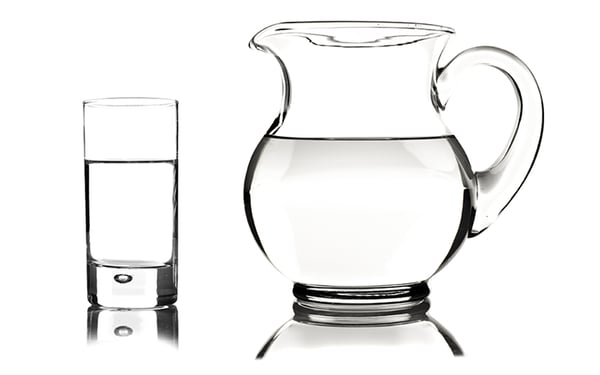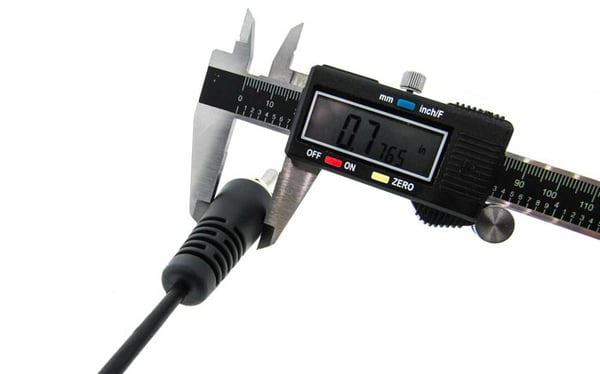Scientists and engineers are sticklers about the units for any measurement, and rightfully so. The technique of using units' cancellation remains one of the fundamental concepts taught in all higher education STEM courses. Whether the course is chemistry, physics, thermodynamics, or even aerodynamics, the criticality of units is ever-present throughout lecture, calculations, and lab studies.
Product specifications and engineering drawings also demand this crucial focus on measurement units for some of the reasons articulated below. But the importance of units on measurements exists far beyond the scientific community and can be applied to your weekend batch of homemade waffles. To demonstrate this, trying to make a batch of waffles and intentionally use ½ tablespoon of salt, instead of ½ teaspoon of salt. My oldest daughter learned the hard way that one teaspoon does not equal one tablespoon. To further elaborate on this, see the example below.

If you place a glass of water in a room that is 100 degrees, is the water a solid, a liquid, or a gas? (And for the scientists who are already scrutinizing this example, you can assume that this room is at sea level with standard atmospheric pressure).
Some people may answer that the water is going to be a liquid. Others may suggest that if the water is left for too long, it will evaporate so it would be a gas. But the correct answer could be any of those three, and the reason is simple: we intentionally did not specify the units of temperature.
The first possible answer would be liquid since most are familiar with degrees Fahrenheit. One hundred degrees Fahrenheit is the temperature of a warm tub. The Fahrenheit temperature scale, which is widely used in the U.S., was originally developed to provide a 0°F reference point for saltwater freezing. Another possible answer would be gas since water boils at 100°C. The Celsius temperature scale, which is used throughout most of the world, aligns the freezing point and boiling point of water using a 0-100 scale. The third possible temperature unit of measure would be the Kelvin scale (which technically does not use degrees, but hopefully the point is clear). The Kelvin temperature scale references absolute zero, the coldest possible temperature, as 0°K. This scale is used in various scientific calculations and is widely agreed as the most representative temperature scale since temperature, which is defined as the motion of particles within an object, technically cannot be negative.
Typical Measurement Units for Cable Assemblies
Technical data sheets and engineering documentation are riddled with critical information requiring the appropriate use of measurement units. For cable assemblies, the overall length is usually described in inches or millimeters, but there are times when feet, meters, or even centimeters are used to define the cable. Obviously, the impact of an unclearly dimensioned cable drawing would be tremendous. Try installing a 60-millimeter-long cable when a 60-inch-long cable is required.
Length, however, is not the only critical property that without proper attention can impact your program. Summarized below are some of the other critical properties and their typical units of measure.
Type of Measurement: Length
Length is a term that is synonymous with distance and is defined as the relative location between two points. Engineering drawings should have clear definition over the units used to describe length. The units of length are usually defined as the title block of drawings, which is usually in the lower right-hand portion the drawing. Often these are boilerplate templates and contain verbiage that says the units are millimeters, inches, or something else unless otherwise noted.
Why this is important?
If the application contains critical dimensions with tight tolerances, rounding errors produced when converting from inches to millimeters can impact pass/fail decisions at receiving inspection. Even worse, if the drawing contains conflicting units’ definition, this can create confusion when kitting and assembly occurs.
Tip: Be sure to be consistent with the units of length and stick to inches or millimeters where possible.

Overmolded cable assembly measured with caliper.
Type of Measurement: Hardness
Hardness is a term that defines the firmness or rigidity of a member, and for plastics and elastomers a durometer instrument is used to define the hardness value. The durometer test process, which is like other hardness tests, measures the indentation of a material when a standardized force and shape is pressed.
Why this is important?
The majority of overmolded cable assemblies define the overmold material’s hardness using the Shore A durometer scale. The majority of flexible overmolded materials that are flexible are in the 60 Shore A to 90 Shore A scale. The different Shore scales are completely different with no direct correlation. Sixty Shore A is not even close to the same hardness as 60 Shore D.
Tip: Many materials come in a range of hardness values. If a specific hardness or durometer is needed for you application, specify the durometer using the Shore A scale.
Type of Measurement: Wire Size
Wire size, or gauge, a usually defined as the size of the conductor cross section. In the US, AWG (American Wire Gauge) is used to define the wire size. As AWG increases from 12AWG to 20AWG, the cross-sectional area decreases. Typically wire size is available in 2AWG increments, so the available AWG options would be 12AWG, 14AWG, 16AWG, 18AWG, and so on. In numerous other areas of the world, wire size is defined as the conductor cross sectional area in mm2.
Why this is important?
Not all AWG sizes have a direct match for the metric equivalent wire. In most cases the wire sizes are close enough between the two standard such that form, fit, and function are not impacted. For example, the cross-sectional area of 6AWG wire is actually 13.3 mm2, but in many scenarios a 16 mm2 metric wire would do the job. The same issue demonstrated here is also apparent with ring terminals and studs.
Tip: Be sure to be consistent with the units of wire gauge and where possible utilize AWG for consistency.
| Metric Size to AWG Size | |||
|---|---|---|---|
| Area (mm2) |
Size AWG |
Nominal Overall Diameter (mm) |
Nominal Overall Diameter (in) |
| 42.41 | 1 | 8.43 | 0.332 |
| 35 | 7.65 | 0.302 | |
| 35 | 7.56 | 0.298 | |
| 33.62 | 2 | 7.42 | 0.292 |
| 26.67 | 3 | 6.61 | 0.260 |
| 25 | 6.39 | 0.252 | |
| 21.15 | 4 | 5.89 | 0.232 |
| 13.30 | 6 | 4.67 | 0.184 |
| 10 | 4.05 | 0.160 | |
| 8.37 | 8 | 3.71 | 0.146 |
| 6.0 | 3.12 | 0.123 | |
| 5.26 | 10 | 2.95 | 0.116 |
| 4.0 | 2.55 | 0.101 | |
| 3.31 | 12 | 2.34 | 0.092 |
| 2.5 | 2.01 | 0.080 | |
| 2.08 | 14 | 1.85 | 0.073 |
| 1.5 | 1.56 | 0.062 | |
| 1.31 | 16 | 1.47 | 0.058 |
| 1.0 | 1.29 | 0.051 | |
| 0.82 | 18 | 1.02 | 0.046 |
| 0.75 | 0.98 | 0.039 | |
| 0.52 | 20 | 0.81 | 0.032 |
| 0.50 | 0.80 | 0.031 | |
| 0.33 | 22 | 0.64 | 0.025 |
| 0.25 | 0.56 | 0.022 | |
| 0.20 | 24 | 0.51 | 0.020 |
The above wire size, cross sectional area, and diameter are For Reference Only. Please refer to manufacturers' wire data sheets for actual values.
All the Details Matter
Designers and manufacturers are always working to drive down cost and time from the development process. There are countless strategies and techniques that can be explored to improve the time to market and increase profitability. Sometimes inconsistencies with a small detail such as the units of measure within your documentation can create a tremendous ripple effect on your development schedule and budget. So, the next time your engineer fails to clearly specify the units of length, hardness, or wire size, you can remind them that the units of measure are critical. And the next time you make waffles with your family, try swapping teaspoons with tablespoons of ingredients to further demonstrate why the units of measure are so important.
Summary
The accuracy of measurement units is critical in cable assembly design and manufacturing, as even small inconsistencies can lead to major production errors, quality issues, or costly delays. Engineers must clearly define and consistently apply units across all documentation, from cable lengths to material hardness and wire gauges. Miscommunication or unit conversion errors can result in nonconforming parts, rework, and wasted resources. By maintaining unit consistency, whether in inches versus millimeters, Shore A versus Shore D hardness, or AWG versus metric wire sizing (manufacturers can ensure that products meet design specifications and function as intended), it’s essential for reliable and efficient production.
Key Takeaways
- Unit Consistency Is Critical: Always verify and standardize units in engineering drawings to prevent errors caused by conflicting or unclear measurements.
- Length Conversions Can Cause Issues: Converting between inches and millimeters can introduce rounding errors that impact tolerance-sensitive applications.
- Hardness Scales Differ: Shore A and Shore D durometer scales are not interchangeable; always specify the correct scale when defining overmold materials.
- Wire Gauge Standards Vary:S. designs typically use AWG, while other regions use metric measurements. These systems don’t always match perfectly, so verify equivalence.
- Small Details Have Big Impacts: Overlooking unit accuracy can cause costly rework, delays, and nonconformances, reinforcing that precision matters at every step of design and manufacturing.
















